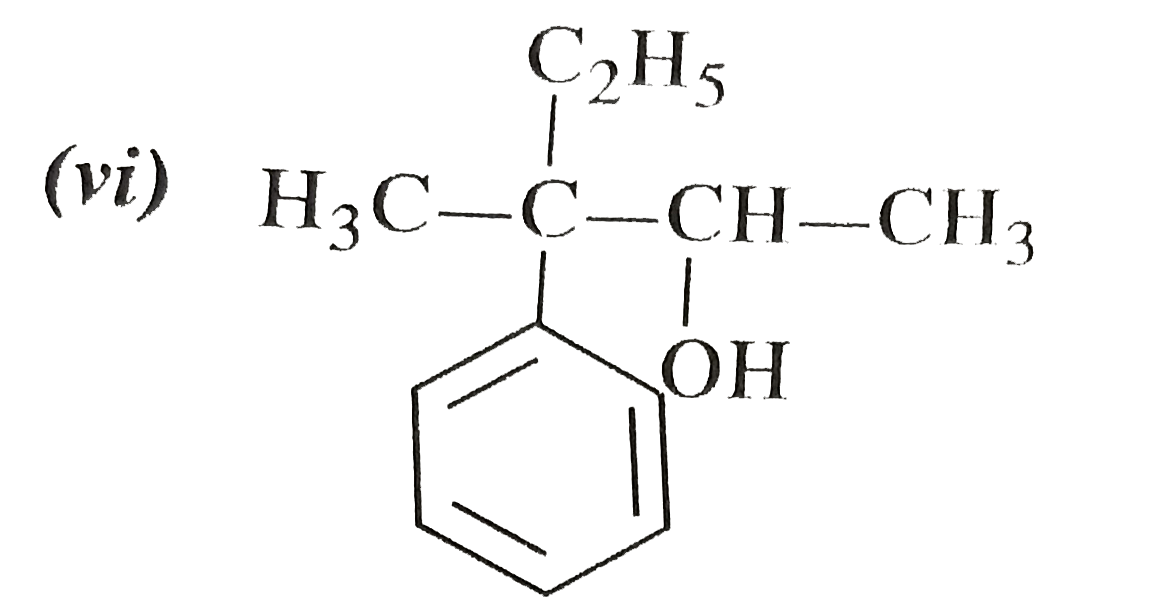CH3−CH=C*=CH2में तारांकित कार्बन कौन सी संकरण अवस्था रखता है
sp
sp2
sp3
इनमे से कोई नहीं
The correct Answer is:A
Step by step video, text & image solution for CH_(3)-CH=C^("*")=CH_(2)में तारांकित कार्बन कौन सी संकरण अवस्था रखता है by Chemistry experts to help you in doubts & scoring excellent marks in Class 11 exams.
Updated on:21/07/2023Topper's Solved these Questions
Similar Questions
निम्न में से किसका सही IUPAC क्रमांकन है।
View Solutionनिम्न में से कौन सा यौगिक धनात्मक बेयर परीक्षण देता है :
View SolutionGiven the IUPAC names of the following compounds: (i) CH_(3)CH_(2)CH_(2)underset(C_(2)H_(5))underset(|)overset(CH_(3))underset(|)(C )CH_(2)-overset(CH_(3))overset(|)(C )=CH_(2) (ii) CH_(3)-overset(CH_(3))overset(C )H-C-=CH (iii) C_(6)H_(5)-CH=CH-CH_(2)Cl CH_(3)CH-CH-CH_(2)Cl (iv) CH_(3)CH=CH-CH_(2)Br v CH_(2)=CH-overset(Cl)overset(|)(C )-CH=CH_(2) vi CH_(2)=CH-overset(CH_(2)CH_(3))underset(|)(C )H-underset(Cl)underset(|)(C )=CH_(2) vii. (CH_(3))_(3)C - CH=CH_(2)
View SolutionName of the following as substituted derivatives of ethylene.
(a) CH3−CH=CH−CH3
(b) CI2C=CHCI
(c) (CH3)2C=CH2
(d) (CH2=CH)2C=CH2
(e) (CH2=CH)−CH=CH−(CH=CH2)
View SolutionCH_(2)=CH-C-=C-CH=CH-CH_(3)
View SolutionGive the IUPAC names of the following compounds:
(i)C6H5−CH2−CH2−OH (ii)CH3−CH3∣C∣CH3−CH2−CH2−OH
(iii)[(CH3)2CH]3COH. (iv)CH3−CH∣OH−CH2−CH2−O−CH2CH3
(v)CH3−CH2−CH∣Cl−CH∣CH3−CH3∣C∣OH−CH3 (vi)
(vii)(CH3)3COH (viii)CH3−CH∣CH3−CH∣OH−CH2−CH∣CH3−CH3
(ix) CH2OH |CH2−CH2−CH−CH−CH−CH3 | | CH2Cl CH3, (x) CH3−C=C−CH2OH | | CH3Br
(xi) CH2=CH−CH∣OH−CH2−CH3, (xii) CH2OH |CH3−CH−CH2−CH−CH−CH3 | | CH3 OH
View Solutionनिम्नलिखित यौगिकों के आई.यु.पी.ए.सी.नाम लिखिए |
(i) (CH3)2CH−CH=CH−CH3−CH || CH3−CH−CH ∣ C2H5
(ii)
CH2=C(CH2CH2CH3)2
(iv) CH3CH2CH2 CH2CH2CH3 | | CH3−CHCH=C−CH2−CHCH3 ∣ CH3
View Solutionनिम्नलिखित यौगिक का सही नाम है -
CH3 |CH3CH2−C=CH−CH−CH2−CH3 |CH3CH2−CH−CH2−CH2−CH3
View Solutionनिम्नलिखित यौगिकों के IUPAC नाम लिखिए-
(i) CH3 |CH3−CH2−CH−CH−C−CH3 | | | CH3 I CH3
(ii) Cl |CH3−CH2−CH−CH−C−CH3 | | | CH3 OH CH3
View SolutionWrite the IUPAC names of the following compounds: (i) (C_(2)H_(5))_(2)CH-CH=CH_(2) (ii) CH_(2)=CH-overset(C_(2)H_(5))overset(|)(C)H-CH_(2)-C-=CH (iii) CH_(2)=underset(C(CH_(3))_(2))underset(|)(C)-CH_(2)-CH_(3) (iv) CH_(3)-CH=CH-C-=CH (v) CH_(2)=CH-overset(CH_(3))overset(|)(C)H-CH_(2)-CH=CH_(2) (vi) CH_(3)CH_(2)C-=underset(H_(2)C=CH)underset(|)(C CH)-CH_(2)CH(CH_(3))_(2) (vii) CH_(3)CH_(2)CH_(2)overset(CH=CH_(2))overset(|)(C)HCH_(2)CH_(2)CH_(2)CH_(3) (viii) CH_(2)=CH-overset(CH_(3))overset(|)(C)H-overset(CH_(2))overset(||)(C)-CH_(2)-C-=CH (ix) HC-=C-C=CH-CH=CH_(2) (x) CH_(2)=C=CH-CH_(2)-underset(CH=CH_(2))underset(|)(C)H-CH_(3)
View Solutionwrite the IUPAC name {:(CH_(3)CH_(2)CH_(2)CH_(2)" "CH_(2)CH_(3)" "CH_(3)),(" | | |"),(" "CH_(3)-CH-C=CH-CH_(2)-CH-CH_(3)):}
View SolutionWhich hybridisation of carbon is same in the following? Give type of hybridisation
(a) CH2=C=CH2 (b) CH2=CH−CH=CH−CH=CH2 (c ) HC≡C−C≡C−C≡CH
(d) CH2=CH−CH=CH2 (e ) CH3C≡C−CH3 (f) C6H6 (g) C6H12 (cyclic comp) (h) CH3−CH=CH−CH=CH3
View SolutionWhich hybridisation of carbon is same in the following? Give type of hybridisation (a) CH_(2) = C = CH_(2) (b) CH_(2) = CH - CH = CH - CH = CH_(2) (c ) HC -= C - C -= C - C -= CH (d) CH_(2) = CH - CH = CH_(2) (e ) CH_(3)C -= C- CH_(3) (f) C_(6) H_(6) (g) C_(6)H_(12) (cyclic comp) (h) CH_(3) - CH = CH - CH= CH_(3)
View SolutionGiven the IUPAC names of the following compounds:
(i) CH3CH2CH2CH3C∣∣C2H5CH2−CH3∣C=CH2
(ii) CH3−CH3CH−C≡CH
(iii) C6H5−CH=CH−CH2Cl
CH3CH−CH−CH2Cl
(iv) CH3CH=CH−CH2Br
v CH2=CH−Cl∣C−CH=CH2
vi CH2=CH−CH2CH3C∣H−C∣Cl=CH2
vii. (CH3)3C−CH=CH2
View SolutionName of the following as substituted derivatives of ethylene. (a) CH_(3)-CH=CH-CH_(3) (b) CI_(2)C=CHCI (c) (CH_(3))_(2)C=CH_(2) (d) (CH_(2)=CH)_(2)C=CH_(2) (e) (CH_(2)=CH)-CH=CH-(CH=CH_(2))
View SolutionWrite down the IUPAC names of the given compounds. a) CH_(3)CH_(2)CH_(2)CH(CH_(3))CH_(3) b) CH_(3)CH(CH_(2)CH_(3))CH_(2)CH_(2)CH_(3) c) CH_(3)CH_(2)CH=CHCH_(2)CH_(2)CH_(3) d) CH_(3)CH_(2)CH_(2)CH_(2)CH_(2)CH_(3) e) CH_(3)CH_(2)CH(CH_(3))CH(CH_(3))CH_(3) f) CH_(3)CH(CH_(3))CH_(2)C(CH_(3)CH_(3))CH_[3) g) CH_(3)CH_(2)CH(OH)CH_(2)CH_(3) h) CH_(3)CH_(2)CH_(2)CH_(2)Cl i) CH_(3)CH_(2)CH_(2)COOH
View Solution
